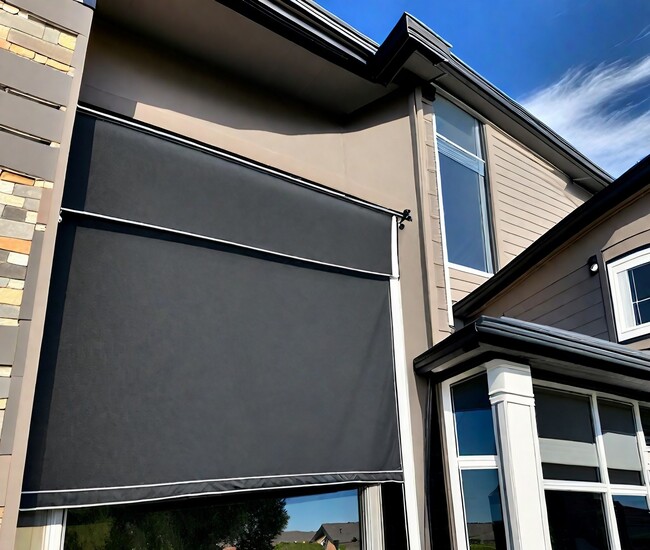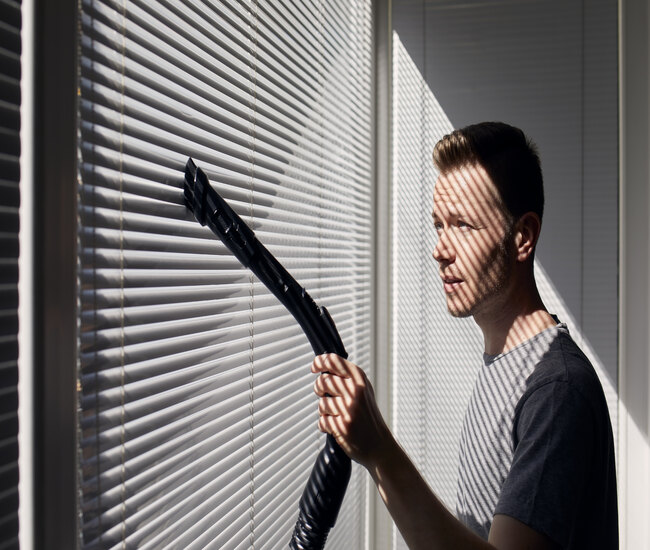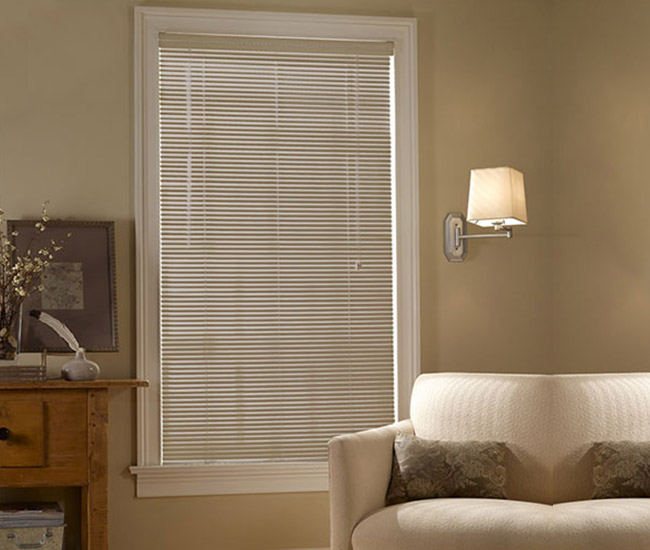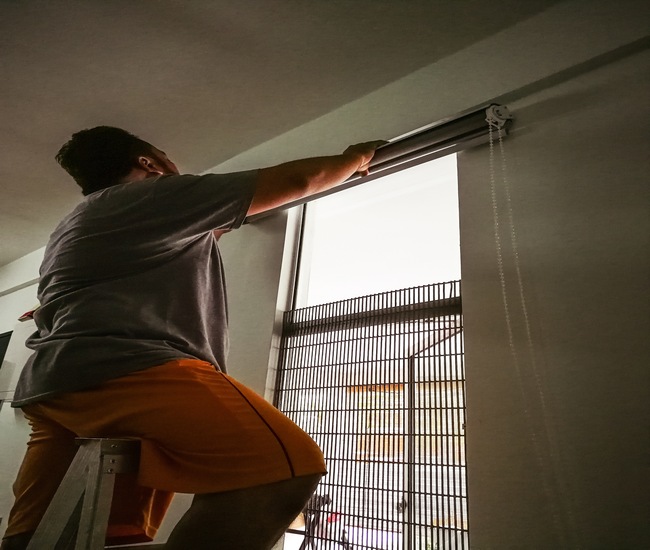What is the difference between a screen and a shade? Looking for a window treatment for sun protection, heat reduction, energy efficiency, and privacy but unable to decide between a solar screen and a solar shade? Both solar screens and solar shades are effective window treatments for UV protection and helping you save on cooling costs. But they differ in their design, method of application, and the extent of benefits.
A solar shade is a protective shield that attaches to your window frame (inside mount) or the area around the window opening to keep the sun from coming inside. Unlike a solar screen, it can be opened or closed (raised or lowered) to give you more control over how much sunlight you allow into your property.
A solar screen is a dark panel that fits in the opening of your porch or pergola and deflects sunlight to reduce glare. Unlike solar shades, solar screens are less expensive options to block the sun’s heat, stop glare, decrease dust, ensure daytime privacy, and protect your indoor furnishing from the harsh UV rays.
Scroll on to learn about key differences between solar screens and solar shades to decide which is better for your sun protection needs.
Solar Screens vs. Solar Shades: What’s the Difference?

Are you looking for a practical and stylish way to keep your home cool during the summer months? Solar screens and solar shades are two popular window treatment options. Both types of window coverings are designed to reduce heat and glare from the sun.
While solar screens and solar shades resemble each other, they do have certain structural and functional differences. Here’s a comprehensive guide about the difference between solar screens and solar shades.
Here are some structural and functional differences between solar screens and solar shade.
Material
Solar screens are usually made from a mesh-like material. On the other hand, solar shades are made of a heavier, opaque material.
Location
While solar screens are installed on the outside of your window, solar shades are installed on the inside.
UV Protection
Solar screens usually block out up to 90% of the sun’s UV rays. On the other hand, solar shades with 1% openness factors can block out up to 99%.
Visibility
Solar screens allow some natural light to pass through them. On the other hand, solar shades offer varying levels of visibility in your room depending on their opacity.
Heat Reduction
Both solar shades and screens can reduce heat from the sun, but solar shades for windows may be more effective due to their heavier material.
Glare Reduction
Both solar screens and solar shades have the potential to reduce glare from the sun, but solar shades may be more effective due to their higher opacity.
Custom Options
Both types of window treatments can be custom-fit to the size and shape of your window frame but solar screens usually offer more color and density options.
Maintenance

Solar screens need occasional cleaning. On the other hand, solar shades can be easily wiped clean.
Price Factor

Solar screens are generally more affordable than solar shades. A high quality solar shade with 10% openness factor for a 37” x 72” (w x h) window will cost about $109. On the other hand, a solar screen for a window of the same size will be much cheaper.
Durability
Solar screens are usually more durable window treatments. Also, they are more resistant to damage than solar shades.
Energy Efficiency
Both solar screens and solar shades can help to improve the energy efficiency of your home by reducing the amount of heat that enters your room through your windows.
Privacy

Solar shades are window coverings that offer varying levels of privacy depending on their opacity level. On the contrary, solar screens do not provide any additional privacy.
Aesthetic Appeal
Solar screens and solar shades have different aesthetic qualities, and they may fit better with different styles of home interior decor.
Outdoor Use
You can use solar screens to create outdoor living spaces. On the other hand, solar shades are designed for indoor use only.
Despite their differences, both these window treatments can help you enjoy cooler temperatures in your home all year round.
Similarities between Solar Screens and Solar Shades
Blocking Out Heat
Both solar screens and solar shades work by blocking out UV rays while still allowing natural light into the room. This helps maintain pleasant indoor temperatures without sacrificing lighting quality or visibility.
Design Options
Additionally, many types of solar screens and shades come with a variety of design options so that you can choose something to suit your style and décor. Whether it’s classic Roman-style fabric shades or sleek solar roller blinds, there is something for everyone!
Benefits of Solar Screens and Shades
Energy Savings
Did you know that up to 30% of your energy bill comes from cooling costs? Solar screens and shades offer an excellent way to reduce those expenses and keep your home cooler. Not only do they provide significant energy savings, but these shades also help control glare, enhance privacy, and regulate temperatures throughout the day.
Reflect Heat Rays without Sacrificing Visibility
Solar screens and shades are made with a special fabric designed to reflect heat away from the window while still allowing light in so you don’t have to sacrifice visibility for comfort. This makes them perfect for hot climates where air conditioning can be expensive. With solar screens and shades installed on all exposed windows in your home or business, you’ll benefit from lower cooling costs as well as improved temperature regulation.
As we move into the next section about installation tips, it’s important to remember that proper placement is essential for achieving maximum benefits from solar screens and solar shades.
How to Install a Solar Screen to Ensure Better Sun Protection
Follow these steps to install a sun screen on the windows in an outdoor or indoor space.
- Step 1: Measure your window frame and order the right-sized solar screen.
- Step 2: Lay the solar screen on the top of the window frame. (It doesn’t matter which side of the screen is up.)
- Step 3: Make sure the screen overlaps the spline channel by at least ½” on all four sides of the frame.
- Step 4: Remove wrinkles and waves of the screen by smoothening it and placing a heavy object in the center of the screen.
- Step 5: To secure the screen frame in place, attach two brick clips on each side of it. Use clear tape to hold the clips in place, if needed.
How to Install Solar Shades for Better Sun Protection

For a professional, inch-by-inch, edge-to-edge fit, follow DIY step-by-step guide on how to install solar shades.
- Step 1: Drill holes (using a ⅜-inch drill bit)
- Step 2: Set up the brackets with screws and a screwdriver.
- Step 3: Hang your solar shades.
With these helpful installation tips in mind, you will be ready to enjoy cooler temperatures with your newly installed solar screen shades!
Maintenance and Care
Maintaining and caring for solar screens and shades is like taking care of a prized possession. You need to keep them in the best condition possible, protecting them from wear and tear over time. Here are some ways you can ensure your solar shades and sun screens remain most effective:
Regular Dusting and Vacuuming
Regularly dust or vacuum sun screens and blinds with an upholstery attachment. Use mild soap and water on hard surfaces to remove stains when necessary.
Ensure Even Distribution of Weight
Make sure all components are functioning properly and adjust tension cords as needed to ensure an even distribution of weight on the shade or screen system.
Making Repairs, If Needed
Check regularly for any tears or loose threads that may need attention before they become larger problems.
Replacing
Replace screens or shade panels if damaged beyond repair as soon as possible so no further damage occurs.
Enjoy both financial and temperature benefits with minimal effort simply by following the steps of proper maintenance for your solar screen and shades! Taking a few preventative measures will ensure that you get maximum longevity from this investment, keeping them in pristine condition throughout their lifetime.
Conclusion
Solar screens and solar shades are window treatments for sun protection, which differ from each other structurally and functionally. However, both solar shades and solar screens are a great way to keep your home cool during the summer months. They help reduce energy costs while still keeping the temperatures inside comfortable and inviting. With proper installation, maintenance, and care, solar screen shades can last for years.
FAQs
What are the disadvantages of solar shading?
- Let Sunlight in Through Gaps: If improperly installed, solar shades will let sunlight in through spaces. Even if your solar shades come with high UV protection, they may allow sunlight into your property along the gaps between the shades and the window frame.
- Inhibit Airflow: If the mesh-like solar screen fabric is tightly woven, it will darken your outdoor living space.
- Less Nighttime Privacy: While solar shades are good at providing daytime privacy, they become see-through when lights are on in your room, allowing people to see inside at night.
Are solar screens worth the money?
Yes! Solar screens can help you save up to 35% on your air conditioning bills in summer. During the winter, solar sun screens can convert the sun’s natural heat into warmth. They also have other benefits, such as noise reduction, privacy, and storm and crime prevention.
Another real advantage of solar screens is that they are one of the most inexpensive window treatment solutions available.
What is better: window tint or solar screens?
Window tint and solar screen are both effective window treatment methods for keeping your home cool and reducing your energy bills. However, they differ in their price and functional versatility. Window tint is a bit costlier, but it offers more benefits and fewer drawbacks than solar screens.
If you want better UV protection and privacy, choose a window tint. If you are looking for the most affordable option, we highly recommend a solar screen as a better choice.
Solar screens can block 80% to 90% of the harsh UV rays. On the other hand, a window tint can block 99% of ultraviolet rays, while allowing 100% visibility and reducing glare to ensure a better viewing experience on screens. Also, window tint is more durable and more transparent.
Need More Help?
Still unsure which one is a better choice: solar screens or solar shades? Speak to one of your friendly consultants today using 24/7 live chat or give us a ring at (800) 863-6109 for expert advice and custom solar shading solutions.
